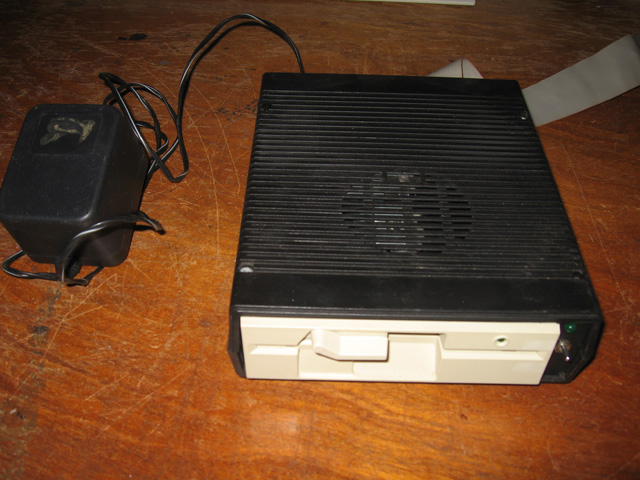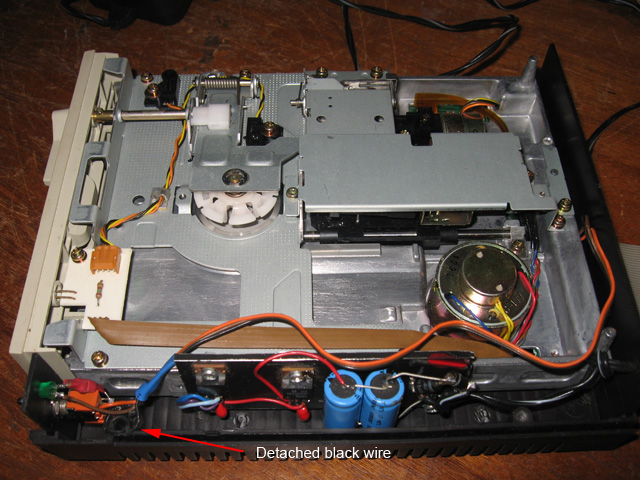New acquisition - External 40-track, double-sided 5.25 inch drive for anything that needs it
Meh. You can keep your '90s Mac models and PCs. It's those classic computer models of the early 1980s that most interest me. For many of them, floppy drives were an optional extra. Home computers like the Ataris, Commodores and Sinclairs tended to have their own proprietary drive solutions but many others used off-the-shelf full-height or half-height floppy drives. These computers included the System 80s, TRS-80s, most CP/M machines and of course the IBM PC and compatibles. The latter had cases designed to accommodate drives but for early machines like the TRS-80 Model 1, drives came as external devices which required their own power supply. This is why most "workstations" those days resembled a pile of spaghetti. Every accessory had its own PSU
I've got three external full-height single-sided 40-track drives for my System 80, two half-height 80-track double-sided drives for my BBC(b) and one half-height 80-track double-sided external drive for my Sinclair QL. One would think that would be enough but I was keen to get another just in case any of these failed. One day I spotted one on TradeMe and claimed it for the goodly price of $2.50 (Figure 1).

Figure 1. External 5.25 inch floppy disk drive. - But would it work?
All I knew was that it was an untested external 1/2 height 5.25 inch drive. I was hoping that it worked!
Initial inspection
The drive arrived in reasonably clean condition. The first thing I did was to open the case to discover the drive itself was an Amstrad DFD222A01. Google showed me this drive was 40 track, double-sided. Excellent. This means I could also use it as a replacement for one of my PC 360k drives if they ever fell over.
There was no indication as to the company that had made the external PSU/enclosure. The PSU card slotted in to the right of the drive between it and the black case. Forward of this was a switch. Hmm...the switch had an unattached wire hanging (Figure 2). So there was the first issue.

Figure 2. Problem with the switch. Nothing a bit of solder wouldn't fix!
This needed to be soldered back on before anything would happen. This was duly done. I plugged in and measured the voltage supplied to the switch. 5 volts. Perfect!
Although they seemed pretty gunk-free I cleaned the heads and the rails while I had the drive open. I figured there was no harm in making sure everything was clean and well lubed.
Testing the drive
My TRS-80 Model 4 and software called "Floppy Doctor" is an EXCELLENT combination for testing 5.25 inch drives. The TRS-80 Model 4 is a little weird in that any external drive attached to it needs to be configured as drive 0 rather than the drive 2 as you would expect. The software calls it drive 2 but the jumper needs to be across drive 0. *shrug*
To get to the drive selection jumper was somewhat of a mission as I had to remove the entire case. When I found the pins (on the underside of the drive) I saw that someone had soldered the drive select 1 ones together (Figure 3)!

Figure 3. Someone wanted this drive permanently configured as the second one!
Hmm...no harm done. Some desoldering, straightening with pliers then a jumper over the drive 0 select pins and configuration was set. Then it was a matter of reassembling the case, plugging everything in and switching on.
Floppy Doctor gave the drive an extreme check and workout. Perfect! No errors at all (Figure 4) and compared to those noisy belt-driven full-height drives the mechanism was smooth and quiet.

Figure 4. TRS-80 Model 4 and Floppy Doctor doing what they do. No errors in this case.
While the Model 4 was out I took the opportunity to test my other spare 5.25 inch drives. They were good too!
Reflections
I'm pleased with my $2.50 purchase. It's smaller and easier to drag out than my full-height drive when I want to use my System 80 or TRS-80 Model 1. Even though it's double-sided, it can be used as a single-sided drive for that purpose. It's quiet and takes up less desk room.
I'm happy.
Tezza
6th October, 2012
| Tweet |